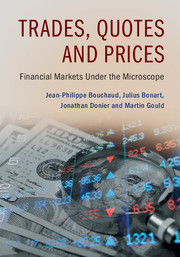Book contents
- Frontmatter
- Dedication
- Contents
- Preface
- Acknowledgements
- PART I HOW AND WHY DO PRICES MOVE?
- PART II LIMIT ORDER BOOKS: INTRODUCTION
- PART III LIMIT ORDER BOOKS: MODELS
- PART IV CLUSTERING AND CORRELATIONS
- PART V PRICE IMPACT
- PART VI MARKET DYNAMICS AT THE MICRO-SCALE
- PART VII ADVERSE SELECTION AND LIQUIDITY PROVISION
- 15 The Kyle Model
- 16 The Determinants of the Bid–Ask Spread
- 17 The Profitability of Market-Making
- PART VIII MARKET DYNAMICS AT THE MESO-SCALE
- PART IX PRACTICAL CONSEQUENCES
- Appendix
- Index
- References
16 - The Determinants of the Bid–Ask Spread
from PART VII - ADVERSE SELECTION AND LIQUIDITY PROVISION
Published online by Cambridge University Press: 26 February 2018
- Frontmatter
- Dedication
- Contents
- Preface
- Acknowledgements
- PART I HOW AND WHY DO PRICES MOVE?
- PART II LIMIT ORDER BOOKS: INTRODUCTION
- PART III LIMIT ORDER BOOKS: MODELS
- PART IV CLUSTERING AND CORRELATIONS
- PART V PRICE IMPACT
- PART VI MARKET DYNAMICS AT THE MICRO-SCALE
- PART VII ADVERSE SELECTION AND LIQUIDITY PROVISION
- 15 The Kyle Model
- 16 The Determinants of the Bid–Ask Spread
- 17 The Profitability of Market-Making
- PART VIII MARKET DYNAMICS AT THE MESO-SCALE
- PART IX PRACTICAL CONSEQUENCES
- Appendix
- Index
- References
Summary
Another issue brought to the fore by the crisis is the need to better understand the determinants of liquidity in financial markets. The notion that financial assets can always be sold at prices close to their fundamental values is built into most economic analysis…
(Ben Bernanke)As we discussed in Chapter 1, organising a market to ensure fair and orderly trading is by no means a trivial task. As we also discussed in Chapter 1, transactions can only take place if some market participants post binding quotes to the rest of the market, in the sense that they specify prices at which they agree to buy or sell a specified quantity of an asset. By posting these quotes, liquidity providers put themselves at risk, because liquidity takers can decide whether or not they want to accept these offers to trade – and will only do so if they believe that the price is favourable. Liquidity providers are therefore exposed to a systematic, adverse bias: while some trades are uninformed and innocuous, other trades may be informed and be followed by large price moves in the direction of the trade, to the detriment of the liquidity provider.
Given this seemingly unfavourable position, why do any market participants provide liquidity at all? The answer is that many liquidity-provision strategies, including the popular strategy of market-making, can be profitable in the long run because a large fraction of trades are in fact non-informed (or very weakly informed). As we noted in Section 1.3.2, the fundamental consideration for implementing these strategies in the long run is the balance between the mean size of the bid–ask spread and the mean strength of adverse impact.
In older financial markets, only a select few market participants were able to act as market-makers. Due to the large spreads that were typical of these markets, market-making was a highly profitable business for these individuals. In modern electronic markets, by contrast, any market participant can act as a market-maker. As we discuss in the chapter, this important change has made market-making a highly competitive business that is typically only marginally profitable.
In this chapter, we introduce and study some simple models that help to make our previous discussions of market-making and the bid–ask spread more precise.
- Type
- Chapter
- Information
- Trades, Quotes and PricesFinancial Markets Under the Microscope, pp. 298 - 318Publisher: Cambridge University PressPrint publication year: 2018

